Right, I got this in the post today. Later then expected so I doubt Ill be able to do that much with it before I have to send it on (grrrr). The guy that sent it too me sure did wrap it up well. It took me about 10minutes with a sak to get into this knife. So was it worth it. Of course it was. Its a chance to try out a fully hand made knife and not be too worried if I put a scratch on the blade. All my other knives are production knives so have a different feel about them. Though this review I have compared the knife to the well known Fallkniven F -a very respectable bushcraft knife which has a RRP of £65 and a Mora knife. The Mora is the starting price for a bushcraft knife and what is recommended by most bushcrafty people to start with. (and in some cases stay with)
Just so that you know what it looks like heres a side on view with the F1 and Mora for comparison
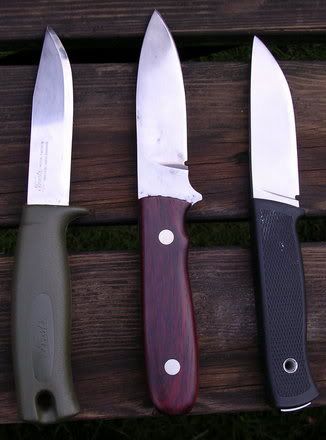
So on to first impressions. This one has a lot more soul then the production knives I use , helped by the wooden handle rather then the plastic of the F1 or the Mora knives. The quality of craftsmanship is of course what youd expect from Shing, the scales fit very well to the tang of the knife and is very smooth, the pins which hold the scales on are perfectly flush and the wood is quite dark which I tend to like and the whole thing seems to have the right proportions. The blade shape from the start of the cutting edge is just what I like. The grind is a full flat with a relatively large secondary bevel. The blade itself is very thick even for a bush craft knife. I think its about 4.5mm or just a touch more. When I saw pictures of the knife I was concerned about using this knife with a baton, there really is no need to fear. There is a rather large ricasso on this knife. These always seem to be a sticking point with knives for bushcraft as it means you cant get as much control when carving with the knife. (More on that point later) Like a number of knives there is a small semi circular cut out between the cutting edge and the choil of the blade, nobody seems to agree on what to call it (its been referred to Spanish notch, sharpening notch, air choil, mini choil and no doubt a few Ive yet to hear). What ever its called this seems to be a thing some people like and some dont, personally I like them. I find the make it easier to sharpen the cutting edge all the way along and means you dont end up with a blunt section of blade that gets longer as the knife gets older (Ive had a fair amount of work sorting out some kitchen knives with this problem) though of course if you pay attention and sharpen on stones it shouldnt be a problem. They do tend to catch on things at times. The handle has a single finger groove for the index finger, which is another thing that gets talked about in bushcraft knives. (Ill come back to that later as well)
With a hand made knife also comes a sheath.
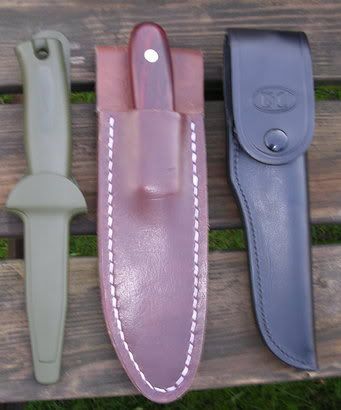
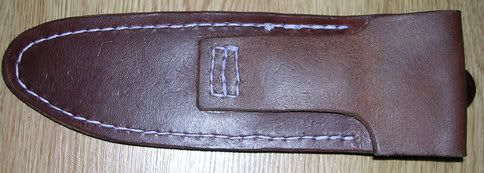
In this case its a simple looking affair with no bit for a fire steel. Some love the idea of keeping your fire steel with the knife but I dont. Many who say they like a fire steel holder agree that is isnt really the best way to carry one. Im not that keen on the sheath. It seems a bit wide and I dont like the colour of the stitching, others might like the contrast It reminds me of sheaths made for Bark River Knife Tool (BRKT) knives. The stitching could be neater but for me it does the job and I think maybe a bit too much glue was used when holding down the belt loop.
The sheath does do the job its meant to well though. There is a nice click as the knife goes into the sheath and it wont fall out if turned upside down. I waved it about a bit (carefully) and though the knife cam part way out it didnt come out completely.
Time for a few more photos of the knife
Just to show how thick this beast is

With the sheaths
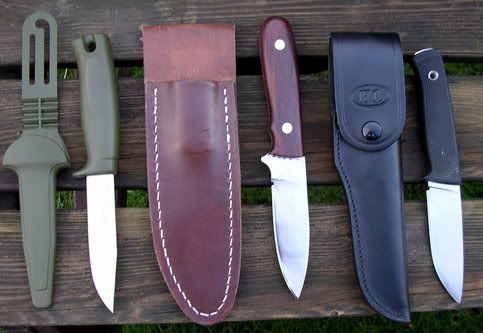
The handle is not square but nor is it too rounded so I did get a firm comfortable grip. Matt also found the grip to be good. He commented, as others have that the F1 handle is a bit too thin for long hard use. This knife isnt much thicker but the little extra makes a big difference. I found the finger groove to be fine in most ways I could think of holding the knife. This was in part due to the handle been quite long. Too long for me. It was also too long for my Dad who does have chunky fingers. With his hands been a bit bigger he found the finger groove to be very uncomfortable. Handles are in my opinion the most difficult bit of a bushcraft knife to get right. The knife has a guard and although its small and during the small amount of use the knife got today didnt really cause a problem there was no point when I felt it was better being there. The whole section of the knife between the end of the scales and the start of the cutting edge seems to be there for no practical reason that I can think of. It just adds weight to an heavy knife.
When I first got the knife it wasnt really sharp. Its wasnt really bad along the straight bit of the edge but the curve running up to the point was very dull. This is due to use from the guys that had it before me. As We didnt have too much time on the first day we used it as it was. I decided one aspect of a flat grind knife might be that it copes better when things have got a bit less sharp. It would still cut free hanging paper but not shave. I hope this gives some indication of the sharpness. Again Ive used the F1 and the Mora for the same tasks for comparison
Batoning through wood.
This knife been thick didnt have any problem with this. It was fine to hold (for me) whilst I hit it through one lump of wood using another bit. Very useful when all the wood you can get to is wet. The shape of the handle was alright but the shaping for the index finger might cause problems for some people if they grip the knife hard. I try not to do that and just let the knife follow the grain of the wood. The F1 did this just as well and the Mora stood up to it. The Mora been much thinner always gives less confidence. I havent split any large logs yet so Ill try and do that in an update. I have no doubt that the knife would stand up as well as any other bushcraft knife to this sort of use.
Making feather sticks
I was surprised at how well this knife was at this. Flat grinds arent normally all that good as this but maybe the secondary edge been quite large gave it a bit more of a guide then most others. It did give very fine shaving though it was harder going. The Mora knife had a tendency to dig too far into the wood and thus give very thick shavings which wont catch fire quite so well. I think its due to the edge been a hollow sabre grind. The F1 has rather a thick edge but was easy to use and more controllable then this knife. It did have a tendency to go deeper but with care it was possible to get nice thin curls. Ill repeat this test after Ive played about with the final edge a bit and see what happens.
This is my go with the knife. Sorry about the blurred photo. It was cold outside and my hands were shaking
The top two bundles are with the Mora, third one down is the F1, next is Shings knife and just for another flat grind knife I tried with my spyderco calypso jr
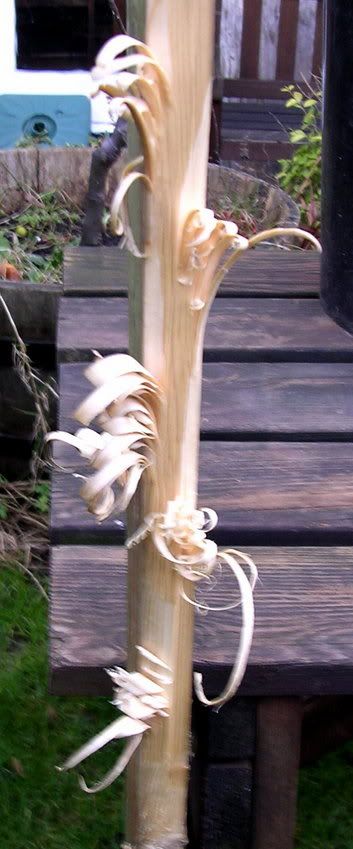
Hammering a small stake into the ground
I havent used this myself when out doing bushcraft but some people use a handle of a knife to bang a stick into the ground with. The ground was soft and it was only a small stake. I thought it was about the right size for a guy line or similar. Well it did this without any problems My hand didnt feel like they would slip off at any point and the weight of the knife did come in handy here. The Mora was pants at it while the F1 did shine at this bit it does have a lump of tang sticking out of the handle just for doing this sort of thing. Id always use another stick if that was possible
OK so the stake was rather long but its wasnt very thick
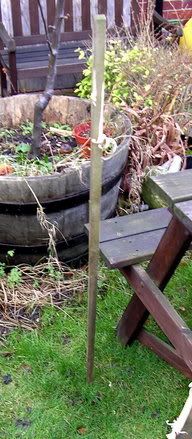
Striking a fire stick with the back of the knife
I coundn't get on with the knife for this task. The way its hardened meant I had to use the tip to get sparks. This reduced control and if I was doing it when I really had too I wouldnt want to have to use this knife for it. When using the method of holding the knife still and pulling the fire steel the knife moved much more then it normally would due to the extra leverage. I dont use my F1 for this either (seems to damage the soft outer metal) so stick to the bit of metal that came with the fire stick. Thus it wouldnt normaly be a problem for me. However when your hands are really cold its much easier to hold a knife then the small bit of steel that comes with the rod. The Mora, once the spine has been filed is very good for using with a fire stick
Food preperation
This section is under construction
I did have a conclusion but decided that Id leave it off for a while until I have got to play with the knife some more. It seemed a bad idea to post a conclusion only to have to change it and run the risk of giving people the wrong impression of the knife.
So any bits you think Im missing let me know and Ill try and sort it out.
Yours
Andy
Just so that you know what it looks like heres a side on view with the F1 and Mora for comparison

So on to first impressions. This one has a lot more soul then the production knives I use , helped by the wooden handle rather then the plastic of the F1 or the Mora knives. The quality of craftsmanship is of course what youd expect from Shing, the scales fit very well to the tang of the knife and is very smooth, the pins which hold the scales on are perfectly flush and the wood is quite dark which I tend to like and the whole thing seems to have the right proportions. The blade shape from the start of the cutting edge is just what I like. The grind is a full flat with a relatively large secondary bevel. The blade itself is very thick even for a bush craft knife. I think its about 4.5mm or just a touch more. When I saw pictures of the knife I was concerned about using this knife with a baton, there really is no need to fear. There is a rather large ricasso on this knife. These always seem to be a sticking point with knives for bushcraft as it means you cant get as much control when carving with the knife. (More on that point later) Like a number of knives there is a small semi circular cut out between the cutting edge and the choil of the blade, nobody seems to agree on what to call it (its been referred to Spanish notch, sharpening notch, air choil, mini choil and no doubt a few Ive yet to hear). What ever its called this seems to be a thing some people like and some dont, personally I like them. I find the make it easier to sharpen the cutting edge all the way along and means you dont end up with a blunt section of blade that gets longer as the knife gets older (Ive had a fair amount of work sorting out some kitchen knives with this problem) though of course if you pay attention and sharpen on stones it shouldnt be a problem. They do tend to catch on things at times. The handle has a single finger groove for the index finger, which is another thing that gets talked about in bushcraft knives. (Ill come back to that later as well)
With a hand made knife also comes a sheath.


In this case its a simple looking affair with no bit for a fire steel. Some love the idea of keeping your fire steel with the knife but I dont. Many who say they like a fire steel holder agree that is isnt really the best way to carry one. Im not that keen on the sheath. It seems a bit wide and I dont like the colour of the stitching, others might like the contrast It reminds me of sheaths made for Bark River Knife Tool (BRKT) knives. The stitching could be neater but for me it does the job and I think maybe a bit too much glue was used when holding down the belt loop.
The sheath does do the job its meant to well though. There is a nice click as the knife goes into the sheath and it wont fall out if turned upside down. I waved it about a bit (carefully) and though the knife cam part way out it didnt come out completely.
Time for a few more photos of the knife
Just to show how thick this beast is

With the sheaths

The handle is not square but nor is it too rounded so I did get a firm comfortable grip. Matt also found the grip to be good. He commented, as others have that the F1 handle is a bit too thin for long hard use. This knife isnt much thicker but the little extra makes a big difference. I found the finger groove to be fine in most ways I could think of holding the knife. This was in part due to the handle been quite long. Too long for me. It was also too long for my Dad who does have chunky fingers. With his hands been a bit bigger he found the finger groove to be very uncomfortable. Handles are in my opinion the most difficult bit of a bushcraft knife to get right. The knife has a guard and although its small and during the small amount of use the knife got today didnt really cause a problem there was no point when I felt it was better being there. The whole section of the knife between the end of the scales and the start of the cutting edge seems to be there for no practical reason that I can think of. It just adds weight to an heavy knife.
When I first got the knife it wasnt really sharp. Its wasnt really bad along the straight bit of the edge but the curve running up to the point was very dull. This is due to use from the guys that had it before me. As We didnt have too much time on the first day we used it as it was. I decided one aspect of a flat grind knife might be that it copes better when things have got a bit less sharp. It would still cut free hanging paper but not shave. I hope this gives some indication of the sharpness. Again Ive used the F1 and the Mora for the same tasks for comparison
Batoning through wood.
This knife been thick didnt have any problem with this. It was fine to hold (for me) whilst I hit it through one lump of wood using another bit. Very useful when all the wood you can get to is wet. The shape of the handle was alright but the shaping for the index finger might cause problems for some people if they grip the knife hard. I try not to do that and just let the knife follow the grain of the wood. The F1 did this just as well and the Mora stood up to it. The Mora been much thinner always gives less confidence. I havent split any large logs yet so Ill try and do that in an update. I have no doubt that the knife would stand up as well as any other bushcraft knife to this sort of use.
Making feather sticks
I was surprised at how well this knife was at this. Flat grinds arent normally all that good as this but maybe the secondary edge been quite large gave it a bit more of a guide then most others. It did give very fine shaving though it was harder going. The Mora knife had a tendency to dig too far into the wood and thus give very thick shavings which wont catch fire quite so well. I think its due to the edge been a hollow sabre grind. The F1 has rather a thick edge but was easy to use and more controllable then this knife. It did have a tendency to go deeper but with care it was possible to get nice thin curls. Ill repeat this test after Ive played about with the final edge a bit and see what happens.
This is my go with the knife. Sorry about the blurred photo. It was cold outside and my hands were shaking
The top two bundles are with the Mora, third one down is the F1, next is Shings knife and just for another flat grind knife I tried with my spyderco calypso jr

Hammering a small stake into the ground
I havent used this myself when out doing bushcraft but some people use a handle of a knife to bang a stick into the ground with. The ground was soft and it was only a small stake. I thought it was about the right size for a guy line or similar. Well it did this without any problems My hand didnt feel like they would slip off at any point and the weight of the knife did come in handy here. The Mora was pants at it while the F1 did shine at this bit it does have a lump of tang sticking out of the handle just for doing this sort of thing. Id always use another stick if that was possible
OK so the stake was rather long but its wasnt very thick

Striking a fire stick with the back of the knife
I coundn't get on with the knife for this task. The way its hardened meant I had to use the tip to get sparks. This reduced control and if I was doing it when I really had too I wouldnt want to have to use this knife for it. When using the method of holding the knife still and pulling the fire steel the knife moved much more then it normally would due to the extra leverage. I dont use my F1 for this either (seems to damage the soft outer metal) so stick to the bit of metal that came with the fire stick. Thus it wouldnt normaly be a problem for me. However when your hands are really cold its much easier to hold a knife then the small bit of steel that comes with the rod. The Mora, once the spine has been filed is very good for using with a fire stick
Food preperation
This section is under construction
I did have a conclusion but decided that Id leave it off for a while until I have got to play with the knife some more. It seemed a bad idea to post a conclusion only to have to change it and run the risk of giving people the wrong impression of the knife.
So any bits you think Im missing let me know and Ill try and sort it out.
Yours
Andy
